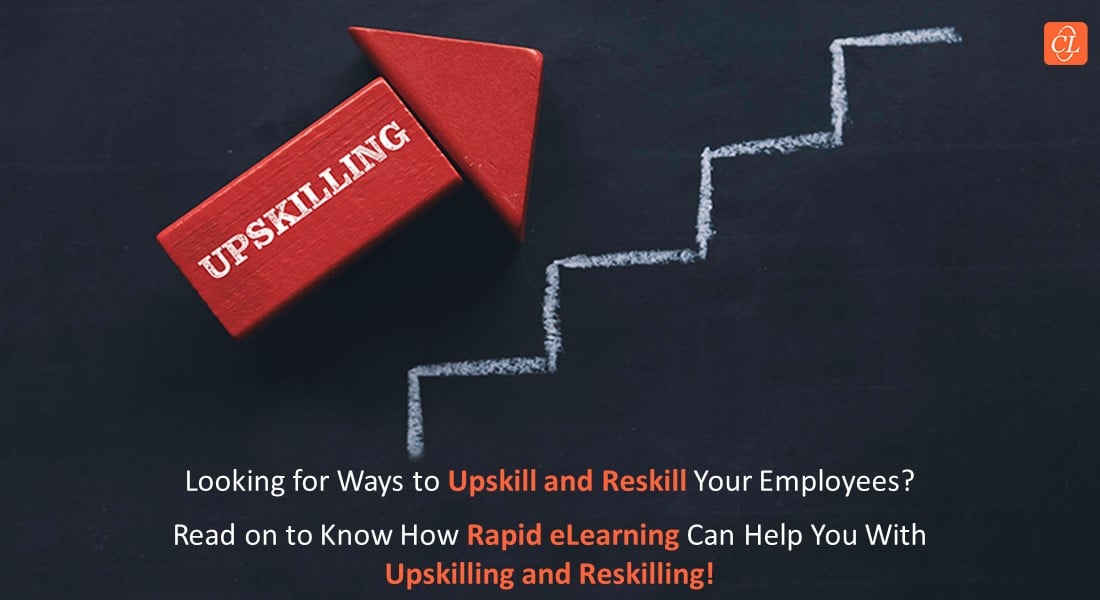How Does Rapid eLearning Help in Upskilling and Reskilling Employees?
In this article, we will go over how eLearning has the potential to upskill and reskill staff in fast-paced environments, be it for technical training, product training, customer handling, and more.

Rapid eLearning can be a powerful tool for upskilling and reskilling employees in areas that are bound to have numerous and regular updates or new features. Statista’ s studies have shown that employees worldwide are always looking for upskilling and reskilling opportunities.
By using rapid eLearning courses, companies can provide employees with the most up-to-date information in a timely and cost-effective manner. Additionally, rapid eLearning can be used to create customized content that is specific to the needs of each individual learner.
Rapid eLearning: An Effective Solution to Create High-Quality eLearning Courses
Here are the 4 Rs that’ll help in upskilling and reskilling employees:
- Repurposing
- Remixing
- Reusing
- Reinforcing
This allows employees to receive the training they need in a format that works best for them, which can ultimately lead to improved performance and increased satisfaction.
In this article, we will take a closer look at how rapid eLearning can provide employees with the relevant upskilling and reskilling opportunities and what you can do as an employer to get the best out of your courses.
What is Rapid eLearning?
Rapid eLearning is a term used to describe the process of creating eLearning content in a shorter amount of time, using existing assets, resources, and eLearning authoring tools. Rapid eLearning can be an effective solution for companies who need to create high-quality eLearning content quickly and efficiently.
Furthermore, rapid eLearning can be used to create customized content that is specific to the needs of each individual learner, opportunity, threat, challenge, and organization. This allows employees to receive the training they need in a format that works best for them and is suitable for dealing with a specific change. This ultimately leads to improved performance and increased employee satisfaction.
Are you finding it difficult to create digital assets and online training programs quickly? Here’s rapid eLearning to the rescue.
Rapid eLearning Overview for Upskilling & Reskilling
2020-21 saw a decrease in employee training spending, but as the market recovers, it is expected that the industry will grow at a CAGR of 13.9% to reach roughly $487.3 billion by 2030. This growth is not just because of how employers are now focusing on multitasking and the rapidly developing industries but also because of the rise in employee satisfaction seen because of upskilling and reskilling.
These 4 Rs can help to make it an effective solution for upskilling and reskilling:
Repurposing
Reusing existing content and assets can save time and money while still delivering high-quality training.
Remixing
Combining different types of content (e.g., audio, video, text, etc.) can create more engaging and effective learning experiences.
Reusing
Leveraging existing content and assets can save time and money while still delivering high-quality training.
Reinforcing
Using activities and assessments throughout the training can help learners to better retain the information they have learned.
The rapidly evolving workplace means that employees now need to actively adopt the changing environment as well. Technical and product upgrades can often be complex, with a lot of new updates or features to keep track of.
Using Rapid eLearning Effectively
Some tips for using rapid eLearning to create effective technical and product training modules and to improve upskilling and reskilling ventures include:
- Using screencasts to provide employees with step-by-step instructions on how to use new features or update existing ones.
- Creating simulations that allow employees to practice using new features in a safe and controlled environment.
- Using video(s) to show employees how new features work in real-world scenarios.
- Including quizzes and assessments throughout the training to help employees check their understanding and identify areas where they need further assistance.
You can use rapid eLearning to identify your employees’ SWOT (Strengths, Weaknesses, Opportunities, and Threats). It is generally a good idea to implement the science of learning into each and every course; otherwise, the rapid courses may not be as effective.
Upskilling & Reskilling for a Better Organizational & Employee Future
As the world of work continues to evolve, it’s important for companies to invest in reskilling their employees. Rapid eLearning can be a great solution for reskilling employees for future jobs.
Upskilling and reskilling are key strategies for keeping employees up to date on new information and preparing them for future jobs. Rapid eLearning can be an effective solution for upskilling and reskilling employees.
Advantages of Using Rapid eLearning to Improving Skills
There are several advantages to using rapid eLearning to improve employee skills. Some of these advantages include:
- Creating customized content that is specific to the needs of each individual learner and circumstance.
- Providing employees with the most up-to-date information in a timely and cost-effective manner.
- Improving employee performance and satisfaction.
- Preparing employees for future jobs.
Rapid eLearning to End the Tech vs. Talent Crisis
The “tech vs. talent” crisis refers to the growing gap between the demand for technical skills and the supply of qualified candidates. Rapid eLearning can help close this gap by providing employees with the skills they need to be successful in today’s workforce and improve their multitasking capabilities.
Analyzing the need for rapid eLearning can also help employers and managers understand the skills that the organization needs most or what employees are looking for. By molding your eLearning courses accordingly, employers can improve the overall performance of their organization and create a sense of coherence.
Some examples of the skills that rapid eLearning can target include, but are not limited to:
- Technical skills
- Communication skills
- Interpersonal skills
- Problem-solving skills
- Critical thinking skills
- Organizational skills
- Leadership skills
After identifying the skills employees need most and incoming circumstances, it is important that managers and authors tailor their rapid eLearning content accordingly to ensure that everyone is ready for what is coming next.
For example, if you are looking to improve employee communication skills for an upcoming risk that requires impeccable coordination between different teams, you will need to create a rapid eLearning course that covers topics such as active listening, nonverbal communication, and conflict resolution.
Bottom Line
Whichever method you choose, it is important to remember that rapid eLearning can be an extremely effective tool for upskilling and reskilling employees. By using rapid eLearning, you can provide employees with the skills they need to be successful in today’s workforce and stay relevant in the medium and long term. To learn more, download this free eBook on “Rapid eLearning Design for Quick Rollout.”





